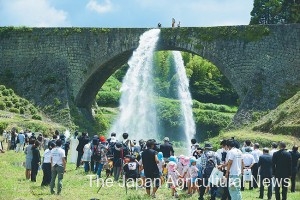TOKYO, Sept. 26 — The education ministry on Sept. 25 designated Tsujun Bridge in the town of Yamato, Kumamoto Prefecture, as a national treasure and issued a notice in the official gazette.
The historic stone bridge is still used to this day to provide agricultural water and it is the first time for a civil engineering structure built for agricultural use to be recognized as a national treasure.
Local people hope the designation will help promote agriculture and tourism in the area.
Tsujun Bridge, one of the country’s biggest arched stone bridges, was constructed in 1854 during the Edo period to supply agricultural water to a nearby plateau.
The bridge is 78 meters long and 21.3 meters high, with a water passage roughly 120 meters long.
The aqueduct’s pipes, maintained and managed by a cooperative organization of farmers in the Tsujun district, are still in use, carrying water to some 110 hectares of rice terraces.
It is highly evaluated for its outstanding presence in the history of new field development during the Edo period.
The Yamato Municipal Government newly issued an ordinance on the bridge designated as a national treasure to preserve it appropriately while utilizing it culturally at the same time.
Certain acts are restricted around the bridge under the ordinance.
The Yamato government also set rules to make it open to the public for viewing.


